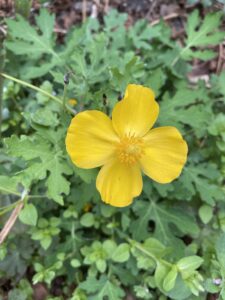
by Mary Reid Barrow
They might be sweet looking, but they are tough!
Despite cold, sudden heat, incessant wind, and my insistence upon waiting as long as possible before cleaning up winter stalks and weeds to protect pollinators, nothing stops a spring native from blooming.
More than any other season, I love the wonder I feel when I first see a spring flower bloom and hungry insects must have the same sense of gratitude.
First up, a month or more ago, were bright yellow wood, or celandine, poppies. They suddenly sent sunshine from a bed that was still full of chickweed. They already have produced some of their fuzzy silver seed pods!
I was so glad to see them and so were the bees.
Little tickseed coreopsis, another cheerful yellow bloomer, was up soon thereafter. They are filling in a sunny bed by the driveway and are so low growing that I’ve decided to let them keep spreading as a groundcover under taller summer blooming plants.
Almost hidden among the wood poppies are sweet native geraniums, open-faced, dainty and pink—another plant loved by me and the bees.

I walked out in the garden, also early on, and surprise! Lynnhaven Carpet daises were up, first one by one and then a whole slew of them.
For sure their soft fuzzy leaves also are a prefect groundcover for summer bloomers. This special daisy was first found on land along the Lynnhaven river where the historic Adam Keeling House is located.

Not long ago the columbine blooms took me by surprise. Columbine walks around the garden, showing up in happy clumps wherever it travels, in the border or out.
It is said that columbine blooms in lockstep with hummingbirds as they migrate north. And every year the timing is right.
Right around the corner from the Lynnhaven carpet, I noticed just last week that my spiderwort was not to be outdone. Little dark blue flowers with yellow eyes cluster at the stem top and work hard, blooming, a few at a time, for just a part of the day.
It is said that the odd arrangement of flowers and leaves is reminiscent of a spider. I have a hard time seeing a spider in the shape, though it is unlike most any other configuration of leaves and flowers I can imagine.

Then there are the blueberries, blooming up a storm, with grateful insects nectaring whenever the sun is out. Small lily of the valley-type flowers drip from Soloman’s seal and wild volets pop up here and there wherever they choose. Tomorrow there will be something else.
With no help from me, natives brave wind and cold to bloom when they should. Insects get their early spring meals, and I get the pleasure of marveling each and every time at what has popped out that day.